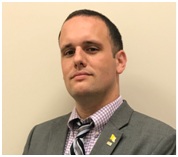Many entities, whether they be private or government, rely on private security professionals to offer a safe and cost effective environment for employees and customers. A common misconception is that a security entity stops a threat on reaching the perimeter of its target. Even though the aforementioned has occurred on certain occasions, the threat is usually noticed and addressed once it penetrates the first, second, and even third circles of what security practitioners refer to as, “The Concentric Circles of Protection.”
Silva Consultants, defines this principle as, “The use of multiple rings or layers of security: The first layer is located at the boundary of the site, and additional layers are provided as you move inward.” Both American and International security organizations use this design to, in essence, catch the fly in the web.
Airline travel is one of the safest and sometimes riskiest forms of travel. Since the inception of airline travel there have always been threats that accompany it. Private security professionals have been outsourced by not only the federal government but also host airlines to protect hundreds of lives and multi-million dollar aircrafts.
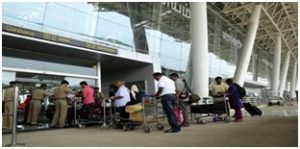 Many of these security officers/security agents will use the Concentric Circles of Protection method to deter a threat before it reaches the aircraft. However, each of the layers must be hardened properly, and the guardians (i.e. – security forces, law enforcement, and military), are to remain vigilant and attentive. Complacency, even for a moment, will have disastrous consequences. Public perception is that only the latter guardians are trained at surveillance and deterring aggressors; unfortunately, most aggressors are as thoroughly trained in observing vulnerable targets as security professionals are trained to spot people or items that may be a threat.
Many of these security officers/security agents will use the Concentric Circles of Protection method to deter a threat before it reaches the aircraft. However, each of the layers must be hardened properly, and the guardians (i.e. – security forces, law enforcement, and military), are to remain vigilant and attentive. Complacency, even for a moment, will have disastrous consequences. Public perception is that only the latter guardians are trained at surveillance and deterring aggressors; unfortunately, most aggressors are as thoroughly trained in observing vulnerable targets as security professionals are trained to spot people or items that may be a threat.
Physical security elements must be married with their human counterparts in order to be effective. The Concentric Circles of Protection get stronger with every implementation of security hardware integrated. Each of the five circles of protection has a human and physical security element paired together in order to achieve the objective of target hardening. There is no facility that can be 100% free of risk; however, with enough security countermeasures housed within the circles of protection, the probability is that acts of terrorism, crime, and sabotage will be detected and deterred.
The Concentric Circles of Protection in an aviation setting are as follows:
1st Circle (Outer Terminal):
Law enforcement or military forces, depending on country, will be stationed outside the arrival and departure terminals to move along vehicles, which will eliminate not only congestion but also potential vehicle-borne improvised explosive devices (VBIEDs).
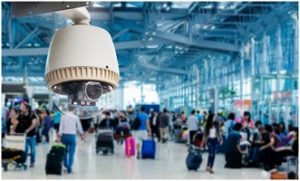 The curbside arrival and departure areas of the public street of the airport property may be affixed with Closed Circuit Television Cameras, which has live feed to either the airport’s law enforcement entity or security operations center. Those uninitiated to the security field believe that the monitor of the cameras will catch the aggressor in the act each time, alerting a response and apprehension.
The curbside arrival and departure areas of the public street of the airport property may be affixed with Closed Circuit Television Cameras, which has live feed to either the airport’s law enforcement entity or security operations center. Those uninitiated to the security field believe that the monitor of the cameras will catch the aggressor in the act each time, alerting a response and apprehension.
Even though the aforementioned does occur at times, it is usually attributed to chance or orders to constantly monitor a specific area. CCTV is more of an investigative tool and is crucial when litigation commences after an arrest or detention.
The outer terminal must be properly lit to not only identify threats on the ground but also so that the individual observing the monitor(s) can better identify, dispatch, and reconstruct physical description and timestamp of an incident. Bollards and barriers on the curbside of an outer terminal are commonplace and essential to deterring intentional and accidental impact, which can cause serious injuries or fatalities.
Crime Prevention Through Environmental Design uses the landscape of the terrain to its advantage in deterring breaches and vandalism to airport properties and inhabitants. For example, territorial reinforcement around the perimeter of the airport property paired with fencing will dissuade someone from attempting a breach. Moreover, motion sensors line airport fences, and if tripped, will send a response in a matter of moments.
2nd Circle (Inner Terminal):
Inside the airport/terminal, private security, homeland security, and law enforcement officers, vigilantly watch for any threats before it reaches the x-ray check points to the passenger gates and tarmac.
 In a digital age, almost nothing can be accomplished or filtered without the aid of a computer system. This is a benefit and force multiplier to this circle of protection. The United States Transportation Security Administration has implemented a, “Secure Flight,” program. The program screens high and low level risk passengers as they book their tickets prior to departure. All identifiers such as social security number, passport number, name, height, weight, and vital statistics are fed through a shared system that matches information to those who are on the watch lists. The beauty of this program is that if the aggressor is, “someone of interest,” he or she is stopped before transitioning from the non-sterile area (outer/public terminal) to the sterile areas past security checkpoints and ultimately on the aircraft.
In a digital age, almost nothing can be accomplished or filtered without the aid of a computer system. This is a benefit and force multiplier to this circle of protection. The United States Transportation Security Administration has implemented a, “Secure Flight,” program. The program screens high and low level risk passengers as they book their tickets prior to departure. All identifiers such as social security number, passport number, name, height, weight, and vital statistics are fed through a shared system that matches information to those who are on the watch lists. The beauty of this program is that if the aggressor is, “someone of interest,” he or she is stopped before transitioning from the non-sterile area (outer/public terminal) to the sterile areas past security checkpoints and ultimately on the aircraft.
3rd Circle (Check Point):
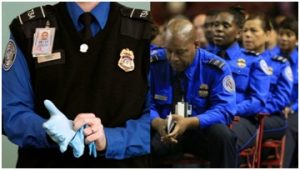 With the aid of roving security and law enforcement entities, transportation security officers, screen/x-ray passengers before reaching the boarding gates. For airports in the New York metropolitan area, Security Identification Display Area badges are issued to all airport employees with a certain level of clearance ranging from cleaners to airport managers. Private security officers will monitor airport employee checkpoints and allow access via a specified swipe card and pin number.
With the aid of roving security and law enforcement entities, transportation security officers, screen/x-ray passengers before reaching the boarding gates. For airports in the New York metropolitan area, Security Identification Display Area badges are issued to all airport employees with a certain level of clearance ranging from cleaners to airport managers. Private security officers will monitor airport employee checkpoints and allow access via a specified swipe card and pin number.
There are common misconceptions when, “aggressors,” are defined in aviation security. As before, those unfamiliar with the security field believe lone wolf terrorists and large criminal organizations are the only human threats airports and airline travelers face. On the contrary, some of the worst acts of crime or sabotage in aviation settings are the result of disgruntled employees, aircraft engineers, baggage handlers, cleaners, catering staff, and even security forces.
The aforementioned are screened prior to employment and monitored to an extent by security managers and supervisors; unfortunately, checkpoint screening for airport and airline staff is usually lax. Security agents posted at checkpoints in the third circle are used to seeing the same co-workers, airline personnel, and law enforcement entities; however, anyone is susceptible to committing immoral acts, and substandard search of a cleaner working for a third party contractor is more dangerous than improperly screening a customer of the airline: Why? Because that cleaner, engineer, or airline representative has intricate knowledge of the aircraft and where the most damage could be inflicted.
4th Circle (Tarmac):
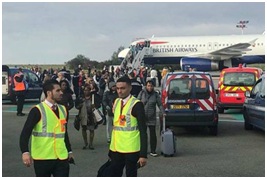 Domestic and international flights are protected by not only mobile law enforcement and government officers but also private security agents. Security agents will monitor the contracted entities such as cleaners, baggage handlers, and food services once in contact with the aircraft. Global Elite Group, refers to this area as the, “Aircraft Footprint.” Each airline carrier has its own security programs and procedures that anyone coming in contact with their aircraft must abide by.
Domestic and international flights are protected by not only mobile law enforcement and government officers but also private security agents. Security agents will monitor the contracted entities such as cleaners, baggage handlers, and food services once in contact with the aircraft. Global Elite Group, refers to this area as the, “Aircraft Footprint.” Each airline carrier has its own security programs and procedures that anyone coming in contact with their aircraft must abide by.
For example, many international airlines require hand wand security screening before engineers, security agents, and baggage handlers physically touch the aircraft. Hand wand metal detectors are very effective; however, they are only as effective as the security personnel using them. Those who are screened via the wand must remove all items from their pockets, arms and legs spread apart, and remain still. The security agent uses a cookie cutter outline method to trace the individual(s) figure and then a sweeping motion of the front and rear of the body.
Many British carriers, on the other hand, require pat downs in lieu of using a hand wand. The latter method is usually met with resistance because the physical touching (although the screening person must wear gloves), makes the screened very uncomfortable. Also, males can only pat down males and females may only pat down females.
Final Circle (Aircraft):
Once at the aircraft, the outbound flight crew and pilots must be on a list known as the, “General Declarations,” or GENDECs. This list is verified by either the aviation security agent or airline representative stationed at the aircraft door. As with below the aircraft, the security agent always verifies identification via an access badge.
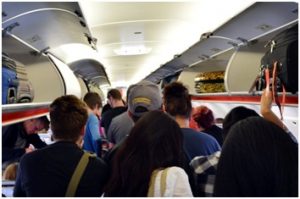 Constant vigilance is key to ensure the Concentric Circles of Protection are successful. Awareness of one’s surroundings as well as private and government security partnerships make this rather simple yet effective security practice a reality. The beauty of this principle is that it may be applied to not only airline security, but may be tailored to any site or property. This method can be inexpensive; however, cooperation from the airline, airport, and employees is key.
Constant vigilance is key to ensure the Concentric Circles of Protection are successful. Awareness of one’s surroundings as well as private and government security partnerships make this rather simple yet effective security practice a reality. The beauty of this principle is that it may be applied to not only airline security, but may be tailored to any site or property. This method can be inexpensive; however, cooperation from the airline, airport, and employees is key.
Security usually falls in the number 2 bracket; time comes first. Many employees tasked with security related duties are rushed or force to do haphazard security checks in order to get an airliner onto the tarmac and departed. Tight flight schedules and fines incurred for not meeting a specific time frame is crippling in the minds of airline personnel. Time is indeed an important factor; however, the security of human lives must never be placed at number 2.
Matthew Porcelli



